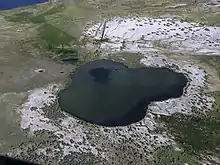Borax Lake chub
The Borax Lake chub (Siphateles boraxobius) is a rare cyprinid fish found only in outflows and pools around Borax Lake, a small lake of the Alvord basin, Harney County, Oregon.
| Borax Lake chub | |
|---|---|
 | |
| Scientific classification | |
| Domain: | Eukaryota |
| Kingdom: | Animalia |
| Phylum: | Chordata |
| Class: | Actinopterygii |
| Order: | Cypriniformes |
| Family: | Cyprinidae |
| Subfamily: | Leuciscinae |
| Clade: | Laviniinae |
| Genus: | Siphateles |
| Species: | S. boraxobius |
| Binomial name | |
| Siphateles boraxobius (J. E. Williams & C. E. Bond, 1980) | |
| Synonyms[3] | |
|
Gila boraxobius Williams & Bond, 1980 | |
This species typically reaches only 2.0 inches (5 cm) in length, although some are as long as 4.3 inches (11 cm). The back is generally a dark olive green, while the sides are silvery, with a dark line extending from gill cover to tail, and a scattering of dark melanophores. The fins are colorless, with more melanophores on the rays of the dorsal fin and tail, as well as on the first four rays of the pectoral fins. Similar in many ways to the Alvord chub, the Borax Lake species has a longer, wider, and deeper head, and larger eyes, and the caudal peduncle is more slender.

The Borax Lake chub eats a variety of foods, including midge larvae, diatoms, copepods, ostracods, and terrestrial insects. Its preferred mode of feeding is to root around in the bottom, but it will go after floating material or feed from the surface if necessary.
This species is the sole fish inhabiting the Borax Lake waters. While parts of the lake itself can, at times, rise to about 100 °F (38 °C) fed from thermal springs, the average temperature ranges between 61–95 °F (16–35 °C). The fish avoid the warmest water, favoring lake's outflows. Its continued existence was threatened by geothermal energy development near the lake, which dried up part of the chub's habitat. However, in 2000 the Steens Mountain Cooperative Management and Protection Act put the area around the lake off-limits to geothermal exploration and mining.[4]
It was listed as an endangered species by the U.S. Fish and Wildlife Department from 1980, when it was listed under an emergency rule[5] that was made permanent in 1982,[6] until July 2020, when it was delisted due to recovery.[7] The Nature Conservancy had bought Borax Lake and surrounding land for conservation management in the interim.[7]: 35586
References
- NatureServe (2014). "Siphateles boraxobius". IUCN Red List of Threatened Species. 2014: e.T9182A18235396. doi:10.2305/IUCN.UK.2014-3.RLTS.T9182A18235396.en. Retrieved 12 November 2021.
- NatureServe (7 April 2023). "Siphateles boraxobius". NatureServe Network Biodiversity Location Data accessed through NatureServe Explorer. Arlington, Virginia: NatureServe. Retrieved 19 April 2023.
- Froese, Rainer; Pauly, Daniel (eds.) (2023). "Siphateles boraxobius" in FishBase. April 2023 version.
- "Borax Lake Chub Species Fact Sheet". www.fws.gov. U.S. Fish & Wildlife Service. Retrieved 14 June 2016.
- 45 FR 35821
- 47 FR 43957
- 85 FR 35574
- NatureServe (2014). "Siphateles boraxobius". IUCN Red List of Threatened Species. 2014: e.T9182A18235396. doi:10.2305/IUCN.UK.2014-3.RLTS.T9182A18235396.en. Retrieved 12 November 2021. Listed as Vulnerable (VU D2 v3.1)
- "Siphateles boraxobius". Integrated Taxonomic Information System. Retrieved 18 April 2006.
- William F. Sigler and John W. Sigler, Fishes of the Great Basin (Reno: University of Nevada Press, 1987), pp. 170–173


